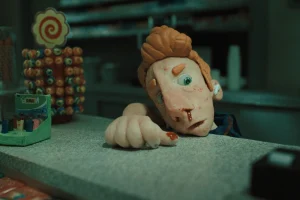In their most frightful confrontation yet, Ed and Lorraine Warren battle a haunted mirror in The Conjuring: Last Rites, the fourth entry in the mainline Conjuring series and ninth movie in the expanded Conjuring Universe opening in Prague and cinemas worldwide this weekend. Despite some terrific 1980s production design and a few memorable horror set pieces, this Conjuring movie isn’t nearly scary enough to compete with James Wan’s first two spook shows, and it doesn’t boast as interesting a story as returning director Michael Chaves‘ previous entry, The Conjuring: The Devil Made Me Do It.
Still, for audiences invested in the continuing story of Ed and Lorraine Warren (as played by Patrick Wilson and Vera Farmiga), The Conjuring: Last Rites should satisfy as a conclusion of sorts to their four-film story. At the film’s outset in 1986, the pair have retired from paranormal ghost-busting following the psychological toll it has taken on spirit-tuned Lorraine, and physical toll it has taken on Ed, who is told by a doctor that his next heart attack will be his last one.
Still, the pair keep a room full of haunted objects that includes the Annabelle doll in its own glass case—you know, just for safekeeping, and as a great icebreaker at BBQs. They tour colleges with tales of their exploits, and are jeered at by rowdy jocks in the wake of the release of Ghostbusters.
The Conjuring: Last Rites opens with one of the most distressing scenes in the movie: a flashback that details the birth of the couple’s daughter Judy in the mid-1960s. An unexpectedly graphic birthing sequence lingers on shots of a motionless baby to a degree that almost feels tasteless, but anyone who has seen the previous films knows that Judy (played by Sterling Jerins in the previous three movies, and Mia Tomlinson here), will make it out just fine.
The Warrens’ concern for their daughter is the primary motivation in The Conjuring: Last Rites, detailed in tender scenes between the parents and Tony (Ben Hardy), Judy’s boyfriend, who requests their approval in asking for Judy’s hand in marriage. These scenes are quietly touching, and empathetically played by the central quartet; were this not a horror film, it might be successful as a kind of retro John Hughes-type thing.
But this is a horror film, and as the Warrens settle into their retirement and Judy and Tony plan their marriage, we’re also regaled with the tale of the Pittsburgh Poltergeist: the haunting of the Smurl family, which consists of eight family members in a tightly-packed domicile in a Pennsylvania coal community. Janet (Rebecca Calder) and Jack (Elliot Cowan), their twin teenage daughters Heather and Dawn (Kíla Lord Cassidy and Beau Gadsdon), two younger daughters, and Jack’s elderly parents are all relentlessly terrorized by vengeful spirits in the usual Poltergeist fashion.
It all started with that creepy antique mirror that grandpa gifted Heather on her Confirmation; now the characters face creepy crawling baby dolls, axe-wielding monsters, ghoulish old women with rotting faces, and—this one might be too much—a poster of John Wayne in the basement. It’s all rather silly stuff, and by the time the Warrens show up and the mirror—which was present at Judy’s birth, and conjured up her appearance at the Smurls—starts spinning around and literally weaponizing itself against these characters, you may have to stifle a laugh. The Conjuring was one of the scariest movies ever made; now, this franchise has devolved into something like 1985’s House.
James Wan mastered the scare sequences in the first two Conjuring films, and he knew that less was more: the suggestion of the supernatural was far scarier than the literal depiction of it. The best scare scene in The Conjuring: Last Rites sees Heather investigate a VHS tape late at night, and discover a demonic face blowing out the candles on her cake. The implication that something was there with her is terrifying; but it’s a lot less terrifying when she turns around and a ghost literally swings an axe at her face.
The Conjuring: Last Rites isn’t very scary, but it is beautifully filmed in 2.35:1 widescreen by cinematographer Eli Born, with evocative 1980s production design and some terrific set pieces. Director Chaves goes over-the-top with the scare scenes to detrimental effect, but they are ingeniously conceived and shot, including one featuring Judy in a bridal shop fitting room surrounded by infinite mirrors.
In the end, The Conjuring: Last Rites feels less like a terrifying send-off and more like a franchise going through the motions. Wilson and Farmiga remain the heart of these films—even if the depiction of their real-life characters is questionable—but their commitment can only carry the material so far when the scares feel factory-built. There’s a quality to the filmmaking here that exceeds most horror movies, and keeps it from being a total wash, but what began as one of modern horror’s most chilling series now closes on a note that’s more ritual than revelation.















